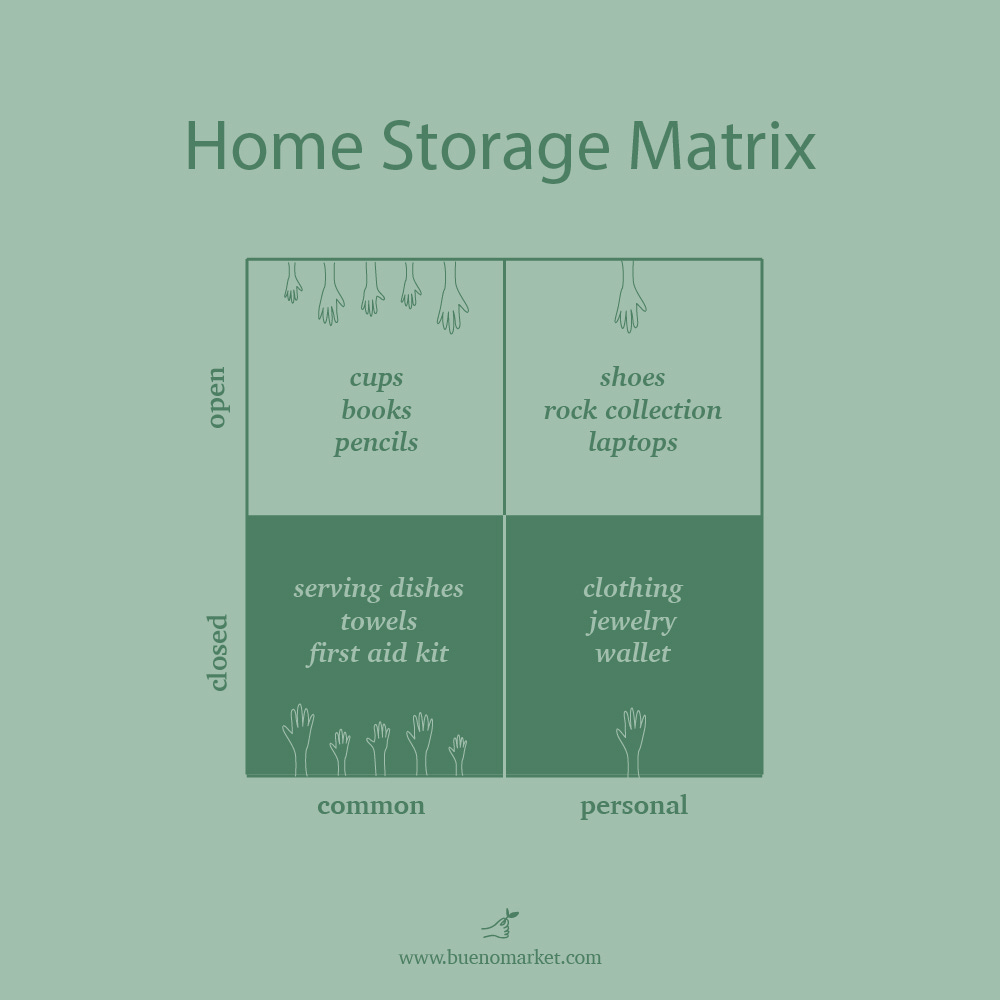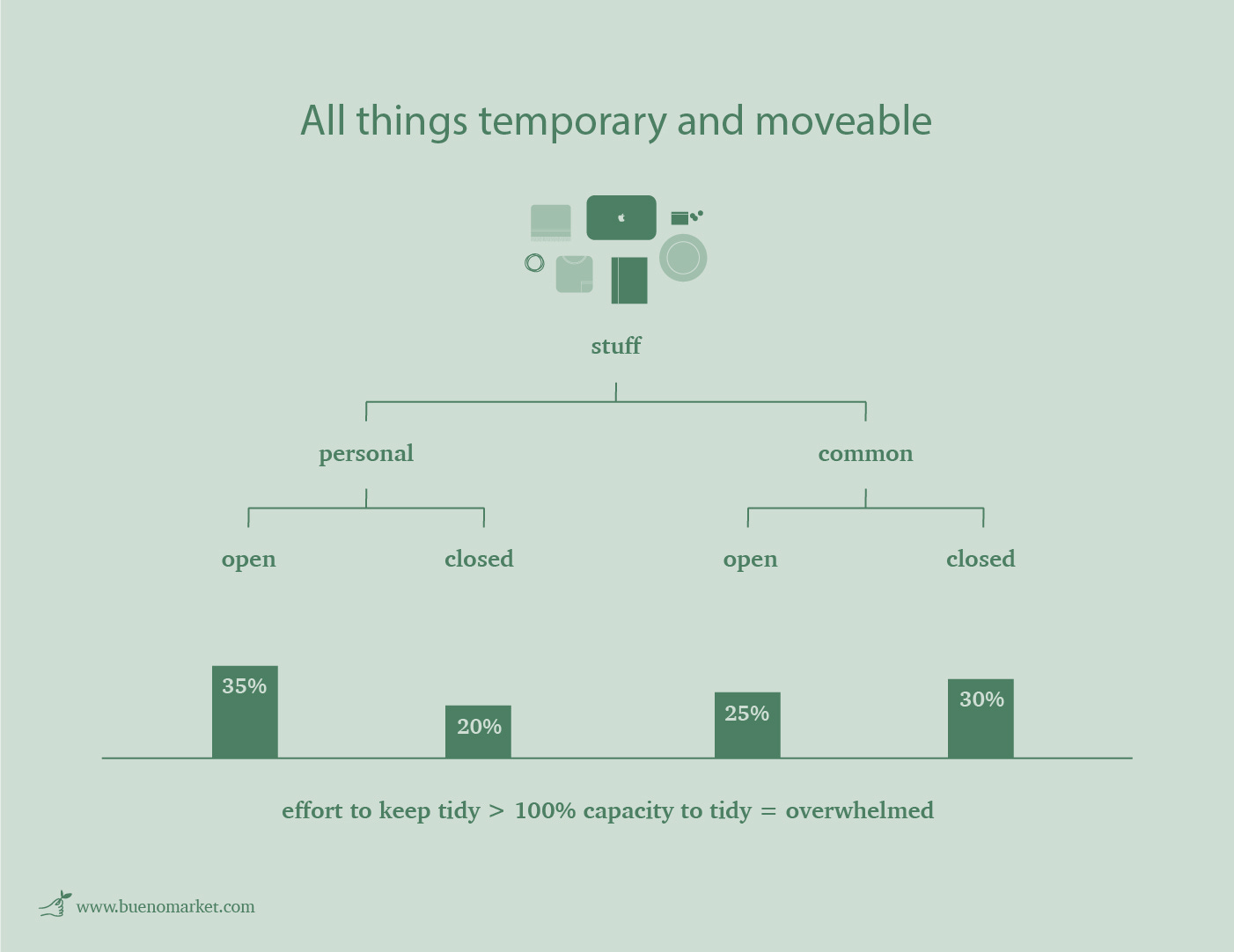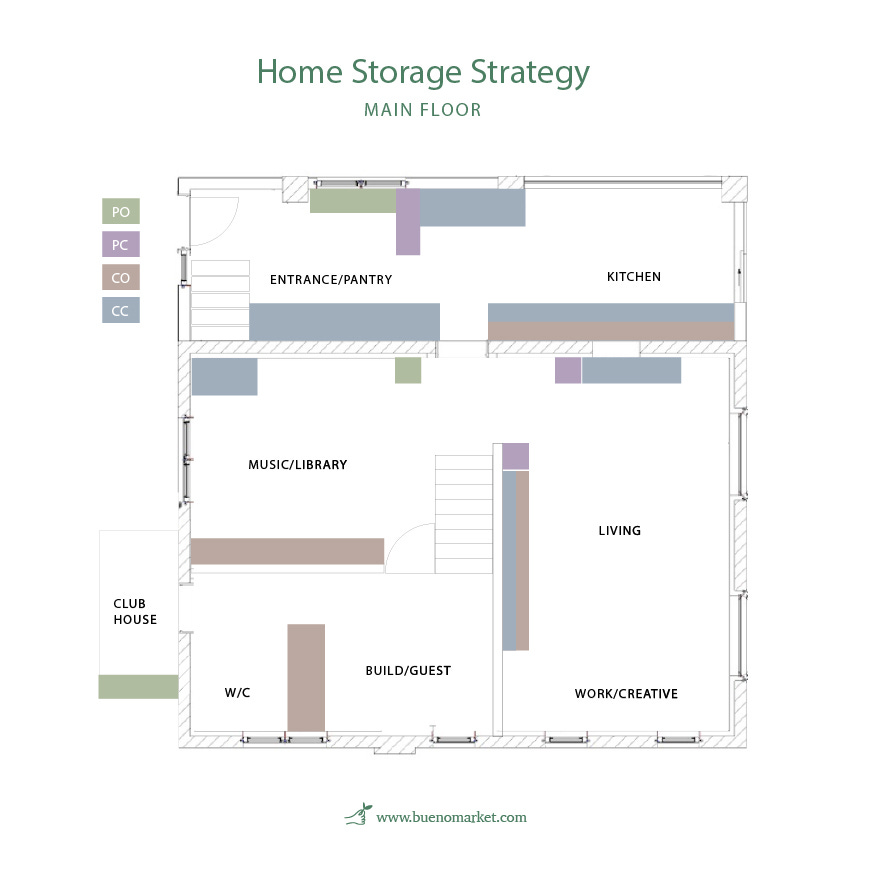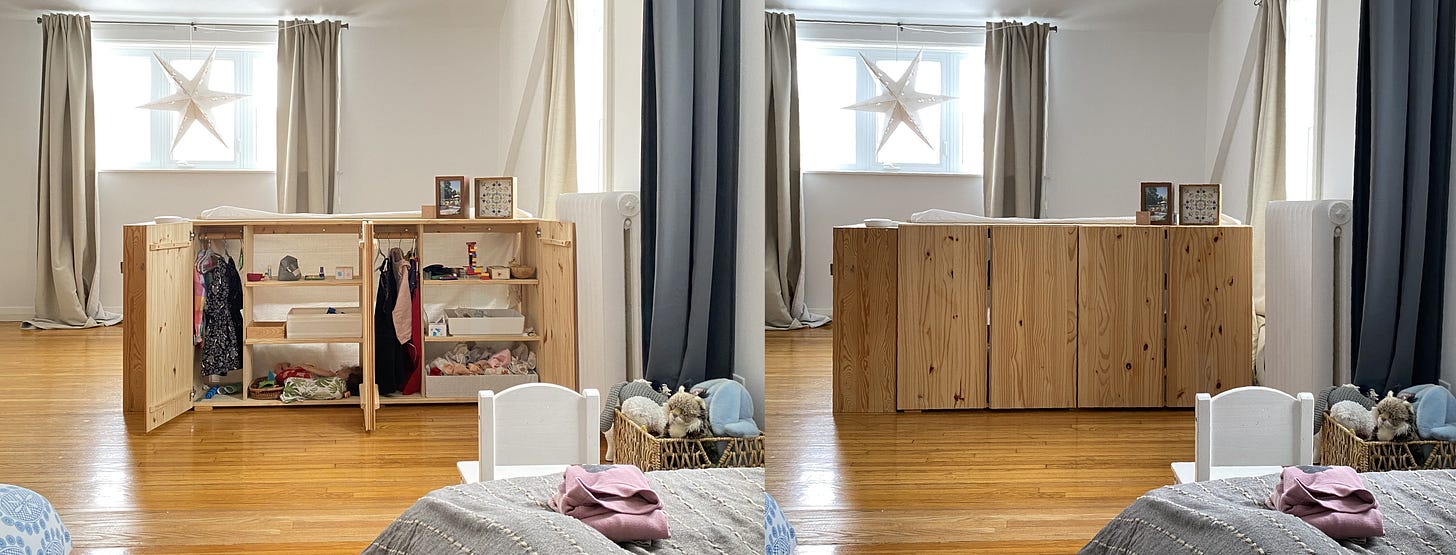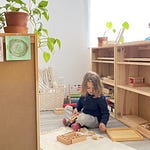This is The Summer Prep Series
The mindset, curation, and organization for a summer of family connection, and growth at home.
…
Months ago, our 6 year old became the only one in the house with her very own walk in closet. By walk-in, I mean a modest 2.5x3ft nook in our 2nd floor hallway. It has a door, a bar tall enough to hang men’s shirts, and a couple of shelves in the back made out of 1/2” plywood, all installed in the 70’s and untouched since.
“Mommy, could I please make it my closet? It’s the perfect space for me”.
And it truly was. It was just the right scale for her to experiment with caring for a place that was all her own.
…
A poetic understanding of stuff
By now, you might have started or are near the end of preparing your space for summer. If you followed along with the process I shared in Methods Over Madness then you:
1) Picked a drop space
2) Gathered all like items
3) Discarded what was no longer serving your family
4) Sorted and and assigned storage, and
5) Introduced your family to the new space.
Last week, I started with our family library because it was low hanging fruit and as the Konmari method has taught me, go for the easy wins first to hone your organizing skills and motivation. This week I’m tackling our main living space which includes our kids Montessori-at-home shelves, their creative/maker space, my office nook, and our family’s creative and hobby storage. That’s a lot of demands on a small space and it’s time to revisit the fundamentals on stuff.
Stuff (noun):
a: obsolete : military baggage
b: Personal property
The former doesn’t help us today, but the later, gives us a poetic way to understand the items we choose to live amongst.
Personal Property (noun):
property other than real property consisting of things temporary or movable
I’m going to take a moment to savour the idea of everything being temporary or movable. Or rather…temporary and moveable.
When I think of my family’s ability to keep on top of our spaces I’ve found it helpful to categorize our stuff or personal property in these 2 categories:
Common items: Things the entire family uses or enjoys
We’re all responsible for caring for these items in our Casita (for the Encanto lovers out there) because when we take care of our home and the items inside of it, they take care of us.
Personal items: Items a specific person uses or enjoys.
If someone other than the owner wants to use or care for this item, they need to ask for permission. This is a very important boundary for maintaining a tidy space and understanding storage needs. This includes shared items, owned by multiple people.
To store these common and personal items, similarly, it’s helpful to think of storage in categories:
1. Common items, closed storage 2. Common items, open storage 3. Personal items, closed storage 4. Personal items, open storage
While I continue to look for research papers with findings on behaviour and tidiness that are both accessible and cover the specifics I want to share with you, I’ll have to rely on my personal experience with tidiness in humans young and old. At the most basic level:
Open storage makes it easier to put things away.
Closed storage makes it harder to put things away.
But there’s a little more to it.
Let’s imagine we have a family home with 100% closed storage.
It could end up being too difficult or time consuming for the children or adults to take items out and put items away every single time. This could lead to many items out of place much of the time, putting greater responsibility on the adults to tidy. It could also mean that many items go unused because they are simply not accessible and are forgotten over time.
On the other side of the spectrum…
Let’s imagine a family home with 100% open storage.
Similarly, it could be too overwhelming and distracting for children and adults to see all household items on constant display. It would be time consuming to dust and clean every item and surface. Even worse, some items like fabrics will get damaged from UV exposure.
It’s safe to say that a balance between aesthetics and function needs to found. Each require their own effort and time commitment. When it comes to family homes, the beauty comes from our intimate knowledge of each members storage needs and capacity to tidy all things temporary and moveable.
…
We are the system makers
As the adults in the household, we have many special abilities. Being a system maker is one of them. We are the ones who create opportunities for order. If something is out of order, we have ability create change.
We can change the environment or nurture skills that will modify the behaviour of our family members using our emotions as fuel. Frustration, anger, resentment and surprise are just some of the feelings that might come up for us when we find a cabinet’s worth of activities mixed up across the living room floor after a Saturday morning. Deep breath - don’t be triggered, right? If you’d like to understand how emotions and action relate philosophically, this 2002 paper titled Emotions and Actions by Jing Zhu & Paul Thagard from University of Waterloo is an accessible and worthwhile read.
When someone in our home leaves something in the wrong place, there are a couple possibilities:
They’re not being mindful. In other words, they’re moving or thinking too quickly.
They are overwhelmed with too much stuff.
In the case of nurturing that slower and more mindful way of being, we’ve learned to:
a) make an effort to model our cleanups, narrating what we are doing when kids are nearby listening; “I pulled out 3 shirts today. Now that I’ve chosen the one I want, I’m going to fold these other 2 (proceeding to fold them with care). Now I’ll place them back into their spot in my wardrobe. Yes, that’s where they go, and now my bed is tidy for tonight when I’m ready to rest.”
In addition to modelling, we find it helps to:
b) make sure we’re finding those quiet times to talk to them about the steps they take when the pull out something to work on, and then put it away. We often make silly songs to remember the steps, or little phrases to help reinforce the rules. Recently, we’ve adapted the nature stewards rule of “Leave no trace” to also be true inside our home. This keeps it more playful and less nagging, an important distinction in tone if we’re hoping to keep our kids in a cooperative mood.
This is a combination of skills and character building that is learned through modelling and repetition starting from birth. It is reason why you don’t often see Montessori families dedicating a space, such as a basement playroom, to kids that is allowed to be kept a mess behind a closed door when adults don’t want to be around it. If you’re up for a challenging read on why disorganization and clutter have negative effects on the brain, you can google your way through this Journal of Neuroscience article on Interactions of top-down and bottom-up mechanisms in human visual cortex, unless you’re a neuroscientist of course. If you’re more generally curious this article on the messy room-teen depression link does a great job of summing up what clutter does to all of our minds, and why decluttering and tidying up is mood changing. I’m excited to dive into this more in a future post.
More likely than my children’s developmentally appropriate mis-steps in tidying after themselves, is that too much stuff has accumulated in our home and in their reach. I love how simple the solution is here - remove some items from the space so it’s less overwhelming for them to cleanup. To help, circle back to Part 2’s methods, specifically gathering all like items, discarding, and then sorting and assigning storage.
By understanding the types of things we need to store, and the reasons why they get left out, we can start to create a house wide storage strategy.
…
A place for everything
When our kids practice using scissors outside, cutting leaves and flowers, make their own french toast, are encouraged to create rather than buy birthday cards and party decorations, harvest what they need from our dyers, edible, and medicinal plants (with supervision), or create their own activities/games using loose parts or open ended items what they are really doing is:
Making use of systems we’ve setup for them.
Modelling behaviour they’ve seen us do, or have done with us.
Making less of a mess at home (…If you’re thinking, Erika, what you are explaining sounds like the opposite - give me a chance. I’ll explain more on Friday!).
Allowing us to have less stuff, and be more efficient with what we do have. I’m excited to write more on this in an upcoming piece about family life and permaculture principles.
This idea of having less stuff is one that we follow for many reasons; environmental, effort-to-keep-tidy/time, mental health, aesthetics, and character building to start. With just a small glimpse as to why we restrict our household items and a promise to share more on that soon, let’s focus today on how we store what we choose to keep at home.
Going back to our categorization of items and storage, we can see how they become useful when planning out our spaces:
PO = Personal Open
PC = Personal Closed
CO = Common Open
CC = Common Closed
This is the main floor of our little Toronto farmhouse.
We’ve created small PO and PC storage along our most frequented path, from our front door to our stairs. This is to reduce clutter by providing a drop space for items that need to be temporarily placed until you’re going in that direction.
The CC storage is also focused along our main circulation spaces, mostly for aesthetics and to reduce distraction but also because it’s convenient enough for us to put items away in these locations frequently.
The CO storage is used in two ways. The first, is tucked deeper into the spaces we spend time in. Spaces we are looking to be inspired in and aren’t in a rush to come or go from. Spaces where we can appreciate a display of items we use and adore. Our other use for CO storage is for quick and easy cleanup and access in our kitchen.
One of the most important factors in determining our current layout and storage needs was to follow where items were being left out and iterate over time.
The kids building blocks:
They were often being left out in the living room, so we dedicated a deeper space within the house to building so that they could create and leave their work out for days at a time without it distracting or interrupting our family’s flow.
Our kitchen counter near the stairs:
It was a mix of hair accessories, snail shells, mail, and Pokémon cards. Now, just 2 feet away, at the edge of our open living room shelves are baskets for each family member to use as a drop space. When they go upstairs or outside they can grab what they need. And every so often, I go through and put everything back in place, making tidying much easier than picking up these item from all over the house.
Our kitchen drying rack:
It was constantly full of dishes and kitchen equipment. It felt onerous to open and close cupboards while 2 of us navigate our small kitchen to put items away, so open shelving organized in a pleasing way felt like the right solution aesthetically and functionally.
…
Everything in it’s place
Grab a sheet of paper, and if the whole homes feels like too much, start with drawing out the storage in your main living spaces - kitchen, living, den, bath, and if you’re in a small space on one floor, that might also include a bedroom or two. Create a second drawing of where items typically get left out. To understand why they get left out, write down who’s leaving them out and why. Is it too much effort? Is it too time consuming? Is it beyond what developmentally they can handle?
Like Isla’s tiny closet, is the the space proportional to their skills?
The personal storage space of our 3 year old (left cabinet), and 5 year old (right cabinet). These spaces are proportional to their abilities. They have one more small space in our main entrance for backpacks and shoes. As they grow, we’ll expand the space they are responsible for.
On Friday, we’ll expand our storage strategy to include the whole house and work towards finding a home for every item. I’ll share pictures and examples of storing specific types of activities on Montessori-at-home shelves. I’ll break down how to decide what get’s displayed “in-rotation”, and what goes in closed storage “out of rotation”. We’ll finish off with specific strategies for keeping on top of what I like to call “child debris” around the home - all those teeny items they bring home from the forest, friend’s homes, birthday parties, the dentist treasure box, and who knows where else.
…
Do you have any specific questions or requests for Friday? Feel free to comment below, message me on Instagram, or email me at erika@buenomarket.com and I’ll do my best to incorporate it into the last post of this series.
Until then, happy strategizing!
Erika
…
What’s next for Raise In Place? Here’s The Summer Prep Series schedule:
Part 1’s resources + weekend challenge
June 14th - Part 2: Method’s Over Madness
June 21st - Part 3: Curation + Organization (you are here!)
June 24th - Part 3’s follow up resources + summer challenge
July 26th - Half-way Check-in
August 30th - Summer Reflection
I would be so thrilled for you to share this newsletter with anyone who could benefit from it!
This newsletter is called Raise In Place, and is the newsletter companion to my Residential Design Consulting Services + Shop, Bueno Market. This Summer Prep post is part of a series inside that newsletter called The Summer Prep Series.
www.buenomarket.com
IG @buenomarket
TW @thebuenomarket
Questions, comments, requests > erika@buenomarket.com




